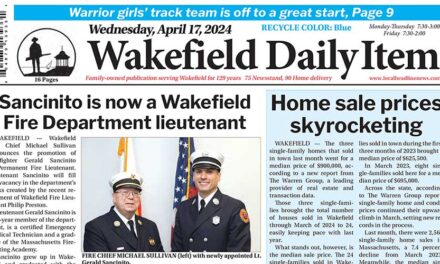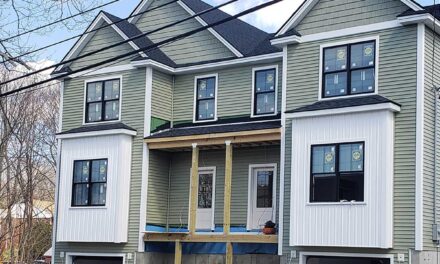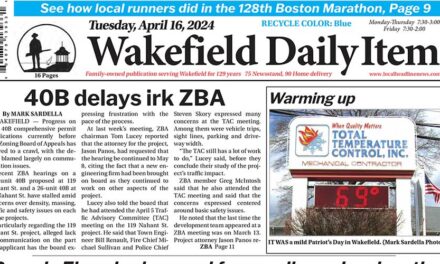Published in the January 20, 2016 edition
By MARK SARDELLA
WAKEFIELD — The Wakefield Public Schools invites the public to attend a presentation tomorrow at 7 p.m. by the architectural/engineering firm Dore and Whittier Architects on the existing conditions at Wakefield Memorial High School.
The presentation will take place at The Savings Bank Theatre at the high school.
Earlier this month before the Permanent Building Committee, Dore and Whittier representatives previewed what the public will see tomorrow night. Dore and Whittier principal Donald Walter, project manager Tom Hengelsberg and education planner Jason Boone walked the PBC through a PowerPoint presentation showing five possible options. Those options emerged as a result of Dore and Whittier’s existing conditions study and the “educational visioning” sessions with school staff, students and parents that have taken place over the last several months.
It was stressed throughout the Jan. 7 presentation that these were only very preliminary ideas designed to show possibilities of what could be done. The work that Dore and Whittier has done over the last six months is expected to culminate in a “Statement of Interest” (SOI) submitted to the Massachusetts School Building Authority (MSBA). The hope is that based on the SOI, MSBA will authorize and help fund a full feasibility study to determine the extent of the work that needs to be done at the High School and how to best address it.
The first option discussed last night was referred to as the “Capital Improvement Plan” or “CIP” option. Hengelsberg said that this option would involve renovating and upgrading the existing building to make it code compliant. This approach would not address programmatic issues that have been identified at the High School, Hengelsberg said, nor would it address all of the school’s accreditation issues.
The cost of the CIP approach, according to Dore and Whittier’s estimates, would be $73,257,656.
In response to a committee member’s question, Walter indicated that there was a good chance that the MSBA would not support or provide any type of state reimbursement for such a minimalist approach, meaning that the town would possibly have to bear the full cost if it decided to pursue the CIP option. (Typically, when the MSBA decides to support a school building project, it reimburses roughly 50 percent of eligible costs.)
The next option shown, listed as “Option 1” involved phased new construction on the present site with a renovated field house. The total cost of this option was estimated at $126,487,588.
“Option 2” as presented would involve a combination of a phased new addition with reuse and renovation of part of the exiting building. Hengelsberg said that it essentially would get rid of the 1972 addition and renovate the 1960 portion of the building. Option 2 was estimated to cost $127,424,866.
“Option 3” would involve constructing and entirely new High School across Hemlock Road on the present site of Walsh Field. Once the new school was built on the present baseball field, the old school would be taken down and a new field and parking would be located there. This option would also shift Hemlock Road slightly and it was suggested that it would improve the intersection of Hemlock Road, Farm and Nahant streets. Dore and Whittier estimated the cost of Option 3 at $121,969,932.
As shown, “Option 4” would involve building a new science wing first and then a phased new addition/renovation on the existing site. This option was estimated to cost $126,282,122.
Under “Option 5,” a new school would be built on Walsh Field, with an addition/renovation of the existing field house on the present site. An enclosed walking bridge would connect the two. The estimated cost of this approach was $122,163,096.
There was some discussion among PBC members of addressing the major issues with the high school science classrooms by constructing a new science building right away and then dealing with the rest of the school needs. Facilities Director Maria Serrao noted that the High School has for several years been on “warning” status with regard to its science accreditation.
Committee members also discussed what they said was a greater likelihood of getting 50 percent MSBA reimbursement for options that involve constructing a new school. They talked about presenting it to the public as cheaper to build a new school than to renovate, because while the total cost of a new school would be greater than a renovation, the state would pay half the cost of a new school, whereas the entire cost of a renovation would be borne by the town if the MSBA elected not to participate in a renovation.
PBC Chairman Joseph Bertrand stressed again that the options that will be presented on Jan. 21 are just possible ideas for what could be done. If, after it reviews the town’s Statement of Interest based on the work of Dore and Whittier, the MSBA authorizes a feasibility study of the High School, all options will be revisited.
“This is the beginning of a long process,” Bertrand said.




